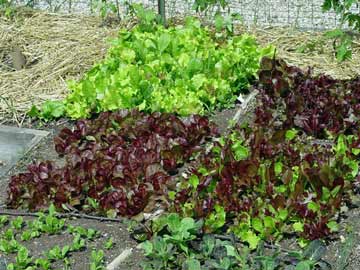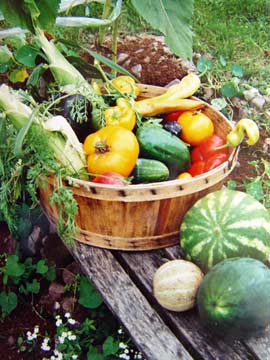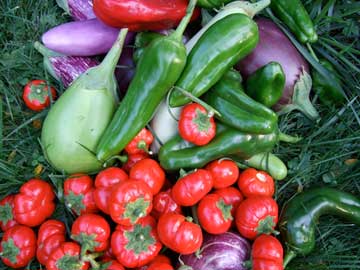Max out nutrition with fresh, home-grown edibles
 Dark-colored edibles are usually more nutrition-packed than similar varieties that are pale in color.
Dark-colored edibles are usually more nutrition-packed than similar varieties that are pale in color.
© George Weigel
Vegetable gardeners often mention freshness, superior taste and cost savings as reasons for growing their own. A fourth and less appreciated advantage is maximum nutrition. Edibles picked and eaten at peak ripeness deliver more nutrition than crops picked early to accommodate shipping to a store. What’s more, gardeners can pick specific varieties that have been bred for high nutrition as opposed to store-friendlier traits such as good looks, durability in transit and long shelf life.
Some easy-to-grow crops are particular nutrition powerhouses – even more than Mom realized when she urged you to eat all of your peas “because they’re good for you.” Research is finding that it isn’t just the vitamins, minerals, fiber and lack of fat and cholesterol in vegetables and fruits that translate into healthier bodies. Natural compounds in plants called “phytonutrients” can also directly protect us from cancer, heart disease and a litany of other chronic health problems. The discovery of specific phytonutrients and their role in disease-prevention not only has contributed to a rebirth in edible gardening – especially in the millennial generation – but it’s spurred breeders to develop new varieties that are super-rich in nutrients. Carrots with high levels of beta-carotene, for example, have been shown to reduce the incidence of several cancers as well as boost the immune system and aid vision.
A Harvard University study found that the lycopene in tomatoes can cut the risk of prostate cancer by a third, while Italian studies found diets rich in tomatoes lowered rates of stomach, colon and rectal cancers. Numerous other studies have linked phytonutrients to disease-fighting properties: broccoli and cabbage in preventing hormone-related cancers; red grapes in preventing blood clots that can lead to heart attack and stroke; melons and berries in boosting the immune system and lowering cholesterol, and onions and garlic in lowering cholesterol and blocking cancer-causing chemicals.
 Home-grown, fresh-picked fruits and vegetables usually pack more nutrition than store-bought varieties that are picked early and shipped.
Home-grown, fresh-picked fruits and vegetables usually pack more nutrition than store-bought varieties that are picked early and shipped.
© George Weigel
In most cases, the compounds that protect us from disease are the same compounds that give fruits and vegetables their bright colors. So if you’re trying to get the most nutritional bang from your edibles, go with the deepest, brightest colors. Deep red tomatoes, for example, generally are the highest in lycopene. Deep orange carrots are higher in beta-carotene than pale yellow ones. Deep green leafy vegetables such as spinach, kale and collard greens are richer in folic acid and carotenoids than the pale green ‘Iceberg’ lettuce typically sold at the supermarket.
To maximize nutrition from the home garden, take these five steps:
 Pick edibles when they’re fully ripe to maximize nutrition.
Pick edibles when they’re fully ripe to maximize nutrition.
© George Weigel
- Grow crops that pack a nutrient wallop. While all edibles are nutritious, some are richer than others and have a complex of phytonutrients that make them health superstars. (See the list below.)
- Choose varieties bred for nutrition. Seed-pack, plant-tag and catalog descriptions usually point out these particular varieties, but sometimes you can tell simply by the variety name, such as the ‘A Plus’ carrot (rich in Vitamin A), the ‘Health Kick’ tomato (rich in lycopene), and the ‘Hi-Beta Gold’ squash (high in beta-carotene).
- Grow under favorable conditions. Most edibles prefer full sunlight and consistent soil moisture to develop to their full potential. They also need adequate soil nutrition, aided by testing the soil and adding a long-acting granular fertilizer as needed.
- Harvest at peak. You’ll not only get the best flavor when picking at full ripeness, but the nutrition also is typically at peak then, too. Don’t pick too soon.
- Eat produce soon after harvest. Nutrients can start to deteriorate within hours of harvest, so the sooner you eat your bounty, the more you’ll reap the most nutrition.
Also helpful is eating produce raw or lightly cooked since heavy cooking can decrease quality and nutrition of most vegetables. The U.S. Centers for Disease Control and Prevention recently ranked fruits and vegetables by their “nutrient density.”
Here are the top 25 on that list (in order): watercress, Chinese cabbage, chard, beet greens, spinach, chicory, leaf lettuce, parsley, Romaine lettuce, collard greens, turnip greens, mustard greens, endive, chives, kale, dandelion greens, red pepper, arugula, broccoli, pumpkin, Brussels sprouts, scallions, kohlrabi, cauliflower and cabbage.
And here’s a list of nutritious crops and their specific benefits that can be grown in a home garden:
- Citrus fruits. Phytonutrients in oranges, tangerines and grapefruits may help the body resist cancer-causing chemicals, prevent harmful blood clotting and avoid blindness.
- Melons, berries. All varieties of these may help the immune system and help lower blood cholesterol. This family includes kiwi, cucumbers, squash, blueberries and pumpkins.
- Grapes. Red grapes may help resist cancer-causing chemicals, protect DNA in cells and prevent harmful blood clots that trigger heart attacks and strokes.
- Cabbage-family vegetables. Broccoli, cauliflower, cabbage, Brussels sprouts, kale, bok choy, collards, turnips, mustard greens, kohlrabi and watercress may lower the risk of hormone-related cancers and help protect DNA.
- Deep yellow and orange fruits and vegetables and leafy greens. Apricots, persimmons, cantaloupe, sweet potatoes, pumpkins and carrots may help protect against cancer, blood clots, loss of eyesight and fatty plaque formation in arteries. Spinach, kale and other dark greens may have similar benefits.
- Tomatoes and eggplants. These may prevent cancer-causing chemicals from forming and attack cancer-causing free radicals. Concentrated tomato products such as tomato sauce and ketchup may reduce prostate cancer and heart attack risk. Peppers are most nutritious when allowed to mature to red, gold, orange or purple.
- Onions, garlics, leeks and chives. These may help the body produce less cholesterol, block cancer-causing chemicals and eliminate toxic chemicals from the body.
- Other fruits and vegetables. Artichokes and stone fruits (peaches, plums, nectarines, cherries) as well as pears, apples, mangos, bananas and avocados provide fiber, folate, potassium and other nutrients that reduce the risk of heart disease and cancer. Both beet roots and leaves are high in folic acid. Squash and zucchini (the skins in particular) are high in lutein, an antioxidant helpful to eye health.